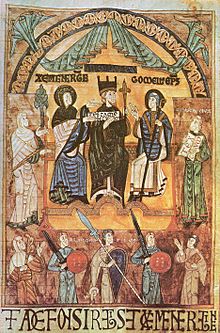Alfonso III of Leon
| Alfonso III | |
|---|---|

Miniature from the archives of Oviedo Cathedral showing Alfonso III flanked by his queen, Jimena (left), and his bishop, Gomelo II (right).
|
|
| King of Asturias | |
| Reign | 866–910 |
| Predecessor | Ordoño I |
| Successor |
Fruela II (Asturias) García I (León) Ordoño II (Galicia) |
| Born | c. 848 |
| Died | 20 December 910 |
| Burial | Cathedral of San Salvador, Oviedo |
| Consort | Jimena of Pamplona |
| Issue |
Fruela II of León García I of León Ordoño II of León |
| Dynasty | Astur-Leonese dynasty |
| Father | Ordoño I of Asturias |
| Mother | Nuña |
| Religion | Roman Catholicism |
| Signature |  |
Alfonso III (c. 848 – 20 December 910), called the Great, was the king of León, Galicia and Asturias from 866 until his death. He was the son and successor of Ordoño I. In later sources he is the earliest to be called "Emperor of Spain." He was also titled "Prince of all Galicia" (Princeps totius Galletiae).
Alfonso's reign was notable for his comparative success in consolidating the kingdom during the weakness of the Umayyad princes of Córdoba. He fought against and gained numerous victories over the Muslims of al-Andalus.
During the first year of his reign, he had to contend with a usurper, Count Fruela of Galicia. He was forced flee to Castile, but after a few months Fruela was assassinated and Alfonso returned to Oviedo.
He defeated a Basque rebellion in 867 and, much later, a Galician one as well. He conquered Oporto and Coimbra in 868 and 878 respectively. In about 869, he formed an alliance with the Kingdom of Pamplona, and solidified this link by marrying Jimena, who is thought to have been daughter of king García Íñiguez, or less likely, a member of the Jiménez dynasty, and also married his sister Leodegundia to a prince of Pamplona.
He ordered the creation of three chronicles which presented the theory that the kingdom of Asturias was the rightful successor of the old Visigothic kingdom. He was also a patron of the arts, like his grandfather before him. He built the church of Santo Adriano de Tuñón. According to a letter of disputed authenticity dated to 906, the Epistola Adefonsi Hispaniae regis, Alfonso arranged to purchase an "imperial crown" from the cathedral of Tours.
...
Wikipedia
